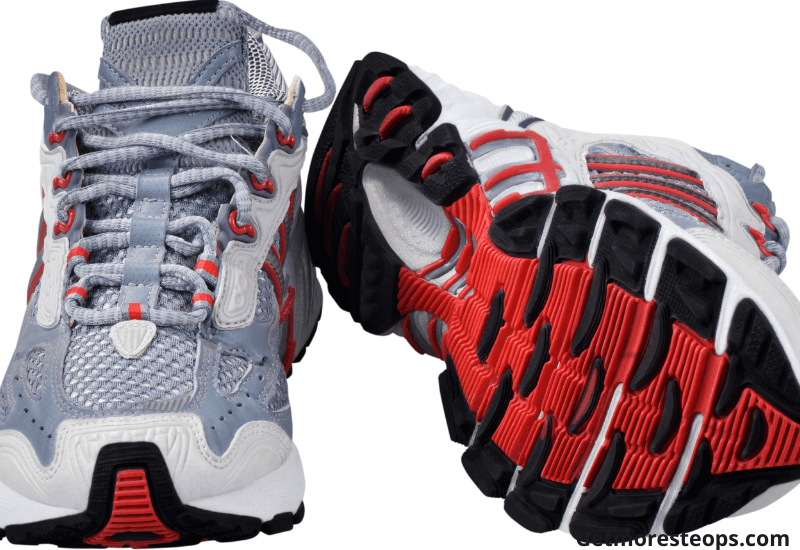Did you know that most people wear shoes that don’t fit their foot’s size and shape? And as a result, a vast majority of them get feet, knees, and back problems? Isn’t it sad? Choosing a pair of walking shoes is not just about choosing a brand, style, and color. The features are the most important factors. So the question is, how to buy the right walking shoes? No worries! This article will give you all the information you need so you can make the right choice for your feet.
What Shoes Do You Need for Your Foot Type
Contents
Before buying any shoe, it’s essential to get some skills about the term of the shoe. This will help you know what type of footwear is best for you. However, it would be best to try shoes on before buying them to not end up with shoes that don’t fit or are uncomfortable.
Overpronation
If you are an overpronator, meaning your feet roll inward, a stability or motion control shoes are what you need depending on the severity of your pronation. Moton control shoes tend to have a firm heel and a straight shape while stability shoes provide some motion control, but tend to have more flexibility, support, and cushioning. These shoes help correct overpronation as they correct your gait, meaning, prevent the inside edge from rolling inward when walking. What you should avoid, though, are shoes with lots of padding because they tend to amplify pronation.
Neutral Pronation
If you have neutral pronation, meaning neutral arches, you can wear almost any shoes you want and be ensured you have all the support and comfort needed. However, semi-Curved shoes are best for neutral pronation. Even if you have no feet issues, that doesn’t mean you can overlook the primary feature of walking shoes. Quite the contrary, by choosing the proper functionality. It will prevent other pronation types.
Supinators (Underpronation )
If you are a supinator, meaning you have high arches (foot roll outward). You should look for neutral shoes ( without stability features like a medial post) and more cushioned shoes that don’t prevent your foot from pronating. Since supinators usually have rigid feet, slip-last flexible shoes would be the best choice. Try to buy shoes with thick materials surrounding the ankle and firm heel counter to provide maximum support at the ankle and heel. Extra padding that sits under the ball of the foot will enhance shock absorption and comfort.
How to Check Your Pronation
Pronation refers to the natural rolling motion of your foot as you walk or run. Some pronation is essential to support the body weight. Ideally, the foot should rolls 15% inward while coming in complete contact with the ground as it helps distribute weight evenly and absorb shocks. However, too much pronation of the feet can cause chronic pain in your knees, ankles, hips, and low back if not treat it. Checking your pronation will help you choose the most appropriate shoes or insert for your feet. Below are several methods that you may consider using.
1. Look at the sole of your shoes. If you see that the middle of the heel area or middle edge of the back edge sole is more worn out, this is a sign you overpronate. On the opposite, if the outside edge of the back sole is most worn out. This means that you supinate.
2. Stand in front of your mirror when you wear something short. Your legs should be straight. If the knees touch each other while standing, there is a fair chance you overpronate. Conversely, if you see more bow-leggedness at the knee and your foot leans toward the outside when placed on a flat surface, you supinate.
3. If you doubt, then the best thing to do is to go to your podiatrist. The podiatrist will analyze your feet and knees and ankles and conclude what type of pronation you have. They often use a treadmill, which identifies the type of gait when you walk on it. This machine is exact and sees every single thing.
4. When standing on a hard floor, ask a friend to put a finger underneath your arches. If the finger can get underneath without effort and without causing any discomfort, your pronation is normal. But, if there is no space and have difficulty putting the finger beneath, this means that you have flat feet, which may cause you to overpronate. If the finger can pass through without touching the arch, this means you have high arches and most chances you supinate.
What Features and Construction Should You Consider?
Outsole
Most shoes are made of hard and durable material (carbon rubber), while others are built with blown rubber, which offers more cushioning but wears out quicker. Some manufacturers produce shoes with both materials, blown rubber and carbon rubber. Hiking and trail walking shoes feature carbon rubber outsole to help withstand trail wear. Running shoes usually have a blown rubber outsole to make the shoes lighter and more flexible. Walking shoes are often made with blown rubber in the forefoot and hard rubber in the heel.
Midsole
The midsole, which is situated between the outsole and footbed, provides stability and cushioning when walking. The midsole is usually made of either EVA(Ethyl Vinyl Acetate), Polyurethane, or some foam types. EVA is lighweight and softer but compresses quicker than any other midsole material, and over time, tends to lose its cushioning and support. Polyutherane, on the other hand, is heavier, firmer, more durable, and doesn’t tend to compress. It’s usually more expensive and used in high-quality footwear. Manufacturers often combine these two types of foam to create a dual-density midsole to provide different cushioning and support degrees. Some manufacturers even add bladders, air, and gel for extra cushioning and support.
Heel counter
The heel counter is a solid material at the back of the shoe that covers the heel. Its primary function is to increase support and reduce overpronation during gait. A good firm heel counter anchors the foot to the midsole and lock your foot, which improves stability and prevents slippage. The heel counter should be neither too snug nor too tight while holding the back of your heel.
Toe box
The toe box is the front part of your footwear that covers and protects your toes. The toe box should be roomy enough for your toes to move freely. If it’s too tight, your toes will be compressed and cause injuries. Conversely, if it’s too spacious, it will also cause injuries and discomfort. There must be at least a half-inch of space between your big toes and the shoes’ edge to fit correctly.
Walking Footwear Considerations
Cushioning
Walking put less stress on the joints than running. Therefore, walking shoes don’t need as much as cushioning than running shoes do. Usually, walking shoes focus more on providing cushioning under the ball of the foot for more comfort and little less in the heel.
Flexibility and support
Flexibility is necessary for fast walking. Look for flexible shoes, but not too flexible either. You also need cushioning; the more miles you cover, the more cushioning you’ll need and vise versa. As a rule of dumb, you want to feel your shoe light to moderate resistance.
Walking style
You should pick a shoe style according to where you’ll be doing most of your walking. For instance, if your walking is mostly on pavement, opt for a casual or multisport shoe. For dirt rails, choose light hiking or trail running shoes.
Shoe weight
If you do brisk walking, you want lightweight shoes with the support of running shoes. Be aware, though, that running shoes are great for walking on treadmills or pavement. The one thing you should avoid doing, though, is to use them for exercises that involve abrupt side-to-side motion.
3 Different Shoe Categories
Walking shoes are grouped into three categories. Let’s see what they are.
1. If you don’t have any stability problems but want to have more motion control, stability shoes are for you.
2. If you don’t need any motion control, then lightweight performance trainers are the perfect shoes for you.
3. If you walk long distances, let’s say more then 5 miles, cushioned shoes will offer you greater comfort while walking.
Tips to get the right fit
1. Ask your shoe seller to measure the width and size of your feet with a Brannock device.
2. Take into account that your feet swell naturally after long day work. So it’s better to try them on in the afternoon, so you get the right fit.
3. Try to wear the same type of socks and avoid cotton socks as they tend to cause blisters. Choose socks that wick away moisture such as Polyester, Nylon, Wool, Micromodal, Coolmax, to name a few.
4. Make sure your longer finger has enough room to move when walking.
5. You should not feel that your feet are slipping around or feel compressed in the shoes after having laced them up.
6. If possible, when trying shoes on, walk around and see if the shoes have good traction and comfort. Check if the shoes are flexible enough, but know that most shoes need a broke-in period, and become softer with wear.
Conclusion
That’s pretty much it. You see, it’s quite easy to choose a good pair of shoes—the only thing you have to do is to follow the guideline. What’s really important is that you feel comfortable in your shoes. So if you find shoes that fit well, then don’t hesitate and wear them!
Do you know other ways to buy walking shoes? If so, I would love to know what they are.

I don’t know about you, but I love my feet because they allow me to walk and go wherever I want to go. Without them, I would be lost! So I always spoil them with a good pair of walking shoes to make sure they are as comfortable as possible. If you take care of your feet, they will take care of you and your health. Well, fitted shoes will protect them and allow you to get more steps without pain!
Read more about me


